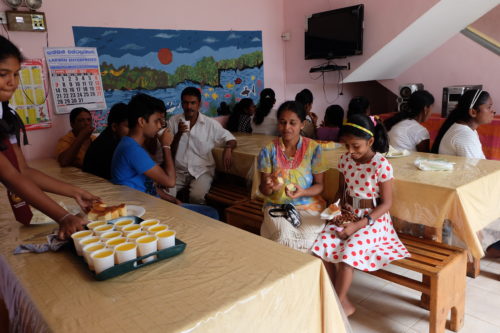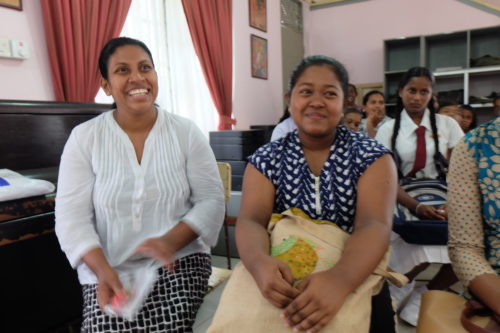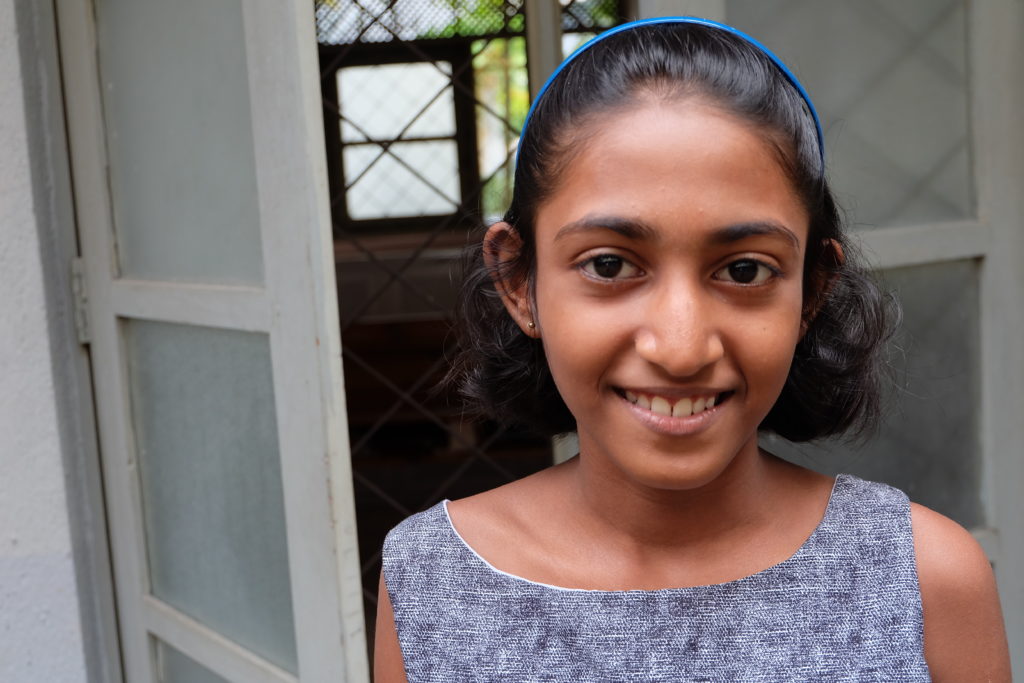Sri Lanka is an island country in South Asia, just below India, that is known for its natural beauty, wildlife, and tea and cinnamon exports. Its heritage rich in Buddhism, Sri Lanka is the oldest democracy in Asia. And although thriving with regard to tourism and commerce, many people in the country live in poverty — especially children who have been removed from their homes by the government because of abuse and neglect, like those that live at the Touch a Life with Hope Center.

Children and their parents enjoy refreshments during our visit.
When Luis Bourdet, Children Incorporated’s Director of International Programs, and I arrived in Sri Lanka, I first noticed how nice the roads were – a sign of development and progress for nations that are considered to be developing or underdeveloped. Since the end of Sri Lanka’s 25-year civil war between the Liberation Tigers of Tamil Eelam (LTTE) and the Sri Lankan government in 2009, a war that caused great hardship for the population, economy, and environment of the country, the focus has shifted to increasing tourism, which has meant improvements to highways, and the construction of more hotels and business, most prominently seen in the capital city of Colombo. Though Sri Lanka is much better off in certain ways than it was eight years ago, the country and its people are still recovering from the instability and lack of infrastructure caused by decades of war.
Fifteen cents a day is not enough
Though Sri Lanka is much better off in certain ways than it was eight years ago, the country and its people are still recovering from the instability and lack of infrastructure caused by decades of war.
We arrived at the Touch a Life with Hope Center, centrally located in Colombo, just a minutes drive from our hotel. The center is tucked away down a small, narrow road lined with tall palm trees. A security wall protects the building, which is not only a home for girls, but also serves as a place for children who live with their families to receive support. Our sponsored children who do not live at the home, but in neighborhoods close by, are both girls and boys. The children attend local public schools, where core academic subjects are taught, including English. Children Incorporated has been affiliated with the home for over thirty years, thanks to a partnership developed by our founder, Mrs. Wood.
We were greeted in the courtyard by a few of the board members; our Volunteer Coordinator, Mrs. Chandini Tilakaratna, was away on business, but her cohorts were more than knowledgeable about the center and its inner workings, and they shared with us in great detail the ways in which the children are provided for at the home. The home was founded in 1982 and is operated by a group of supporters from the community.

A proud mother (left) who works hard to help her daughter stay in school
Most donations to the center come entirely from private donors, either in the form of actual monetary funds or through the donation of clothing and food for the girls. Since the government provides only forty rupees a day for each child — about the equivalent of fifteen U.S. cents — sponsorship is really important in ensuring their needs are met. Although the girls attend free public schools, the cost of school supplies and books is always additional, and the center has little money to use for things other than food and boarding expenses.
Some children go to the Home at a very early age and stay until they are eighteen years old. Currently, 29 girls live at the home, the youngest being seven years old. The sponsored children we met there were of varying ages. They ranged in grade level from elementary to high school. Some of the children have been in our program for as many as fifteen years — a true testament to how sponsorship can support children long-term.
A motivated mother
We met with both parents and sponsored children throughout the day. We spoke with one mother who talked about how she and her husband both work – but the work is never permanent, meaning they don’t have a steady income. She works for a small business that makes and sells crafts, and he works as a rugby coach — two jobs that aren’t consistent year-round, and pay only around 500 rupees a day, or a little more than three U.S. dollars.
Their rent alone costs them 100 U.S. dollars a month, so many times, they have to decide which bills to pay to keep the lights on or to have running water. Money from sponsorship helps her purchase books and pay class fees for tutoring or art classes for her daughter — things that the family would otherwise not be able to afford. The mother talked about how she is very motivated to help her daughter excel, and we could see that she is successfully encouraging her daughter. Her daughter hasn’t finished high school yet, but is already taking nursing courses.
Some of the children have been in our program for as many as fifteen years — a true testament to how sponsorship can support children long-term.
Never without a home
After meeting with the children, we took a tour of the two-story building; we saw the library, the two study rooms, and the computer lab. The center has a lunchroom and kitchen, one dorm for the younger girls and one for the older girls, and showers and a washing area. Each bed has a custom-made mosquito net big enough to cover the entire bunk. There are four full-time matrons who live in separate living quarters at the home, and the center’s administrative offices are in the building as well.
It was explained to Luis and me that when the girls turn eighteen years old, they move out of the home, but continue to receive support for three years as they acclimate to living on their own, and continue their education or find jobs. Sometimes the girls go to live with family, and sometimes they find their own way, but they are always welcome to return to the home to visit – and there is even a bedroom where they can stay the night if they wish.
The center does such a good job of keeping in touch with the girls who have grown up in the home and moved on that they even have special events and holiday parties which they invite them to join. No longer girls, these women, some who moved out as many as ten years ago, return to the home with their own children.
And the women reciprocate the invitation to celebrate as well. As we were leaving for the day, I noticed a bulletin board in the hallway that had dozens of wedding photos pinned to it – beautiful brides stood with their grooms, smiling at the camera. There were thank-you cards to the matrons and administration for having been in attendance on these special days – a gesture that showed me that the girls considered those who raised them in the home family.
***
HOW DO I SPONSOR A CHILD IN SRI LANKA?
You can sponsor a child in Sri Lanka in one of three ways: call our office at 1-800-538-5381 and speak with one of our staff members; email us at sponsorship@children-inc.org; or go online to our donation portal, create an account, and search for a child in Sri Lanka that is available for sponsorship.

